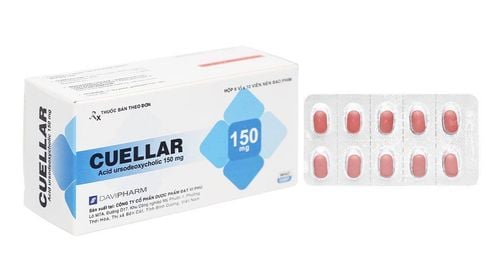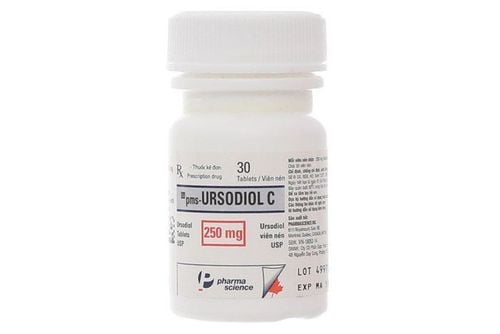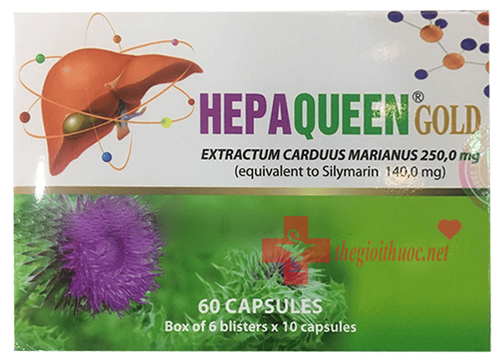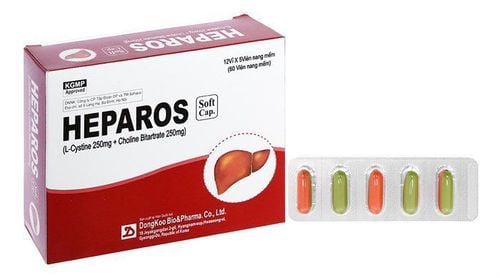This is an automatically translated article.
Granbas medicine has the main ingredient ursodeoxycholic acid, which is made in the form of soft capsules. It is indicated for the treatment of unenhanced cholesterol gallstones in patients with a functioning gallbladder. Let's understand the uses of Granbas and important notes when using the drug in the article below.1. What is Granbas?
Granbas medicine has the main ingredient ursodeoxycholic acid 150mg and other excipients including soybean oil, palm oil, lecithin, white beeswax, glycerin, sorbitol solution, ethyl vanillin, butylated hydroxytoluene gelatin, methyl paraben, propyl paraben , titanium dioxide, allura red AC, tartrazine, brilliant blue just enough for 1 tablet.Granbas drug is produced by Mediplantex Central Pharmaceutical Joint Stock Company, circulated in our country with VD-28183-17. Granbas is available in the form of softgels. Packing includes box of 6 blisters x 10 tablets; Box of 10 blisters x 10 tablets.
Granbas is effective in dissolving cholesterol-free gallstones in patients with a normal functioning gallbladder. In addition, Granbas also supports the protection and recovery of liver cells effectively.
2. Indications and contraindications of Granbas
Granbas is indicated for the treatment of the following cases:
Improve liver function in chronic hepatitis. Protect and restore liver cells before or after drinking alcohol. Anorexia, indigestion due to disorders in the biliary tract. Support treatment of cholesterol gallstones, biliary tract inflammation and cholecystitis Contraindicated to use Granbas for the following cases:
Patients who are sensitive to the ingredients of Granbas drug Patients with bile duct obstruction Pregnant women Granbas ingredients contain soybean oil, so people who are allergic to peanuts or soy should not use this medicine.
3. Dosage of Granbas
3.1. Dosage: Granbas is taken orally and taken after meals
3.2. Dosage: Treatment of cholesterol gallstones:
The effective dose of Granbas is from 5 to 10 mg/kg/day, in people of average condition, the average recommended dose is 7.5 mg/kg/day . For obese people, the recommended dose is 10 mg/kg/day, depending on body weight, the dose of Granbas is 2-3 capsules/day. Should be taken once in the evening or divided into two times morning and evening. The usual treatment time is 6 months, but the treatment time can be extended to 1 year if the stone is larger than 1cm in size. Treatment of chronic hepatobiliary disease:
The therapeutic dose of Granbas is from 13 to 15 mg/kg/day. It is recommended to start with Granbas 200 mg/day, then increase the Granbas dose in a stepwise manner to reach the optimal therapeutic dose approximately 4 to 8 weeks after treatment. In case of acquired hepatobiliary disease due to viscous mucus disease:
The optimal therapeutic dose of Granbas is 20 mg/kg/day. The drug is divided into 2 doses, taken in the morning and evening and taken with meals. 3.3. Treatment of overdose, missed dose.
Missed dose: During the use of Granbas, patients need to follow the doctor's treatment schedule to avoid the occurrence of missed doses that reduce the effectiveness of treatment. It is necessary to apply the exact dose of Verfucas indicated on the package, the drug leaflet or the instructions of the doctor or pharmacist. Do not arbitrarily calculate, apply or change the dose.
4. Granbas side effects
During the use of Granbas, there may be some specific side effects as follows:
Ursodeoxycholic acid does not cause irritation of the intestinal mucosa because of its poor solubility in the intestine. Therefore, cases of diarrhea occurring are very rare. At the beginning of treatment for severe cholestasis, an increase in pruritus and urticaria may occur. Therefore, the recommended starting dose in these patients is usually 200 mg/day. Uncommon side effects: Nausea, vomiting, skin itching, calcified gallstones,...
5. Be careful when taking Granbas
During the use of Granbas, patients should pay attention to the following issues:
For long-term therapy, although ursodeoxycholic acid has no carcinogenic effect, rectal monitoring is recommended. implementation report. In case of treatment of cholesterol gallstones, imaging studies should be performed after 6 months to check the effectiveness of treatment. Treatment of chronic hepatobiliary disease. In patients with cirrhosis associated with impaired hepatocellular function or cholestasis (blood bilirubin level above 200 micromol/L), liver function must be monitored. In case of cholestasis causing pruritus, the dose of ursodeoxycholic acid should be gradually increased with an initial dose of 200 mg/day. In this case, co-administration of cholestyramine is necessary provided that cholestyramine is administered 5 hours apart with ursodeoxycholic acid. Several animal studies have shown teratogenicity in early pregnancy. Therefore, ursodeoxycholic acid should not be used during pregnancy unless clearly needed. The drug has no effect on driving and operating machinery. There are currently no clinical data on the safety of ursodeoxycholic acid in nursing women. Therefore, ursodeoxycholic acid should not be administered to a nursing woman.
6. Granbas drug interactions
Do not use Granbas simultaneously with cholestyramine: The effect of ursodeoxycholic acid is reduced by binding to cholestyramine and being eliminated. If cholestyramine is required, it should be administered 5 hours apart from the time of ursodeoxycholic acid administration. It should not be used with estrogenic drugs, because these drugs cause an increase in bile cholesterol. Avoid using Granbas with other bile acid-binding drugs such as antacids, activated charcoal because it can reduce the therapeutic effect. In the process of using Granbas, patients need to pay attention to follow the doctor's instructions, carefully read the notes before using to be able to bring the highest treatment effect, limit possible side effects. happen.













